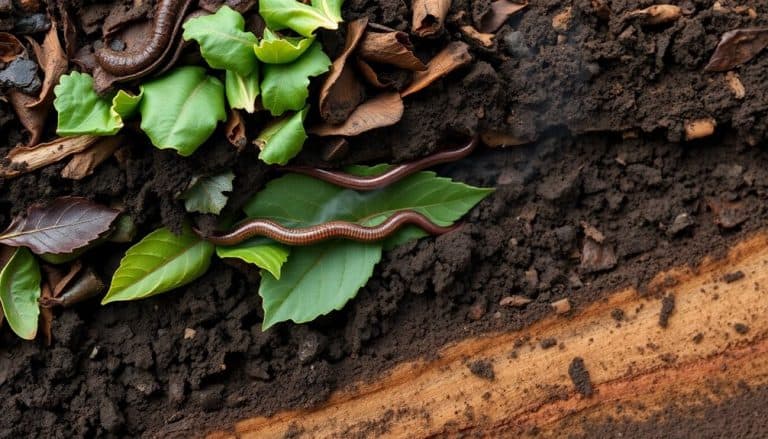This website contains affiliate links. Some products are gifted by the brand to test. As an Amazon Associate, I earn from qualifying purchases. The content on this website was created with the help of AI.
You’ll discover multiple composting methods to suit your specific needs, from traditional backyard piles requiring a 3:1 carbon-to-nitrogen ratio to automated electric systems that process waste within 48 hours. Hot composting accelerates decomposition at 130-150°F, while cold composting offers a low-maintenance approach operating at ambient temperatures. Consider vermicomposting with specialized earthworm species, or explore bokashi fermentation for anaerobic breakdown. Tumbler bins provide controlled environments, while sheet composting allows direct soil application. Container systems offer urban solutions, and trench composting enables in-ground decomposition. These diverse techniques represent a gateway into the fascinating world of organic matter transformation.
Key Takeaways
- Traditional backyard composting is the most common method, requiring a 3:1 ratio of browns to greens and regular turning every 2-3 weeks.
- Vermicomposting uses specific earthworm species to create nutrient-rich soil amendments while maintaining temperatures between 59-77°F.
- Hot composting accelerates decomposition through higher temperatures (130-150°F), producing finished compost in just 4-8 weeks.
- Bokashi fermentation pickles organic matter anaerobically in 10-14 days, reducing methane emissions compared to traditional methods.
- Electric composting systems offer automated processing, reducing organic waste by 90% within 24-48 hours through thermophilic breakdown.
Traditional Backyard Pile Composting

Nearly every backyard composting journey begins with a simple pile, which relies on nature’s fundamental decomposition processes to transform organic waste into nutrient-rich humus. The pile method requires you to maintain a careful balance of carbon-rich “browns” (dried leaves, straw, wood chips) and nitrogen-rich “greens” (grass clippings, kitchen scraps, fresh plant matter) in roughly a 3:1 ratio.
You’ll need to position your pile in a partially shaded area with good drainage, maintaining dimensions of approximately 3’x3’x3′ to achieve ideal thermophilic decomposition. The pile’s core temperature should reach 130-150°F (54-66°C) during active decomposition phases. You’ll want to monitor moisture levels, keeping the materials as damp as a wrung-out sponge, and turn the pile every 2-3 weeks using a pitchfork to facilitate aerobic decomposition.
To accelerate the process, you can inoculate your pile with beneficial microorganisms by adding finished compost or soil, and shred materials to increase surface area for microbial activity. Consider adding a pH-buffered starter formula to maintain optimal conditions for decomposition despite temperature fluctuations. You’ll typically achieve finished compost in 3-6 months, depending on your management practices and environmental conditions.
Tumbler Bin Method

While traditional pile composting harnesses nature’s rhythms, the tumbler bin method offers a more controlled, accelerated approach to decomposition. You’ll use an elevated, rotating chamber that’s sealed from external elements, allowing for precise management of moisture, aeration, and temperature gradients. The enclosed environment accelerates microbial activity while deterring pest intrusion.
To enhance decomposition, you’ll need to maintain a carbon-to-nitrogen ratio of 30:1. Add your organic materials – combining brown carbon sources like shredded paper or dried leaves with green nitrogen sources such as kitchen scraps or fresh grass clippings. The tumbler’s rotation mechanism guarantees thorough mixing of these components, promoting aerobic decomposition through improved oxygen circulation.
You’ll want to rotate your tumbler 3-4 times weekly, which distributes moisture evenly and prevents anaerobic zones from forming. The elevated design facilitates proper drainage and helps maintain ideal humidity levels between 40-60%. Under perfect conditions, you can expect finished compost within 4-8 weeks, considerably faster than traditional methods. Monitor internal temperatures using a composting thermometer; the optimal range is 130-150°F (54-66°C) for maximum microbial activity. Most quality tumblers feature dual-chamber designs that allow you to cure finished compost in one side while adding fresh materials to the other.
Vermicomposting
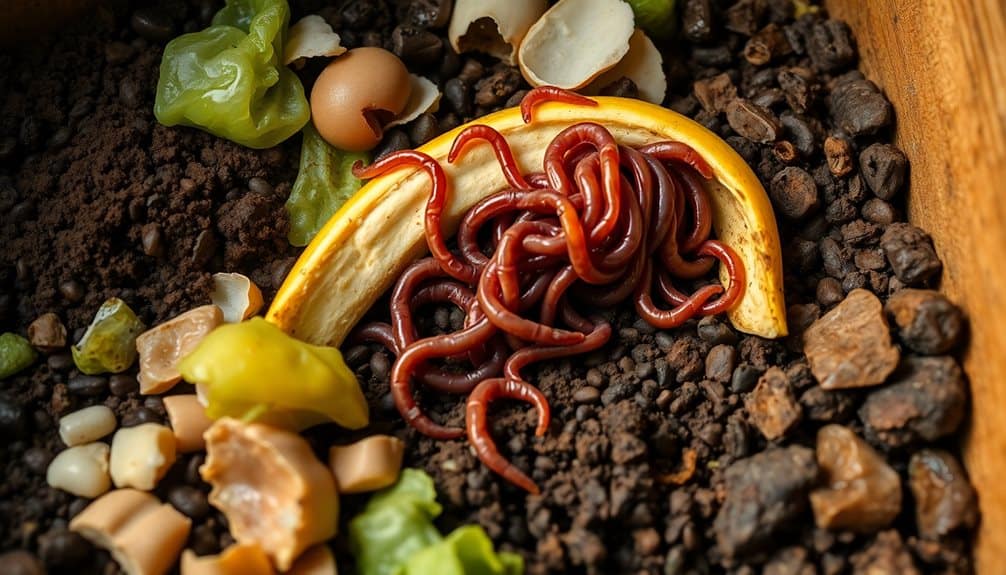
Three distinct species of earthworms – Eisenia fetida, Eisenia andrei, and Lumbricus rubellus – form the foundation of vermicomposting, a bioprocessing technique that harnesses these organisms’ digestive capabilities to break down organic matter. These specialized detritivores consume their body weight daily in organic waste, converting it into nutrient-rich vermicast through their digestive processes.
You’ll need to maintain specific environmental parameters to enhance vermicomposting efficiency:
- Temperature range of 15-25°C (59-77°F) for ideal worm activity and reproduction
- Moisture content between 70-90% with adequate aeration through bedding materials
- pH levels between 6.0-7.0, monitored regularly using a soil pH meter
- Carbon-to-nitrogen ratio of approximately 25:1 maintained through feedstock selection
The resulting vermicompost contains higher concentrations of plant-available nutrients compared to traditional compost, particularly regarding nitrogen, phosphorus, and potassium. You’ll find that the humic substances and microbial populations in vermicast greatly enhance soil structure, water retention, and nutrient cycling. When properly managed, a vermicomposting system can process organic waste while producing premium soil amendments for horticultural applications.
Cold Composting
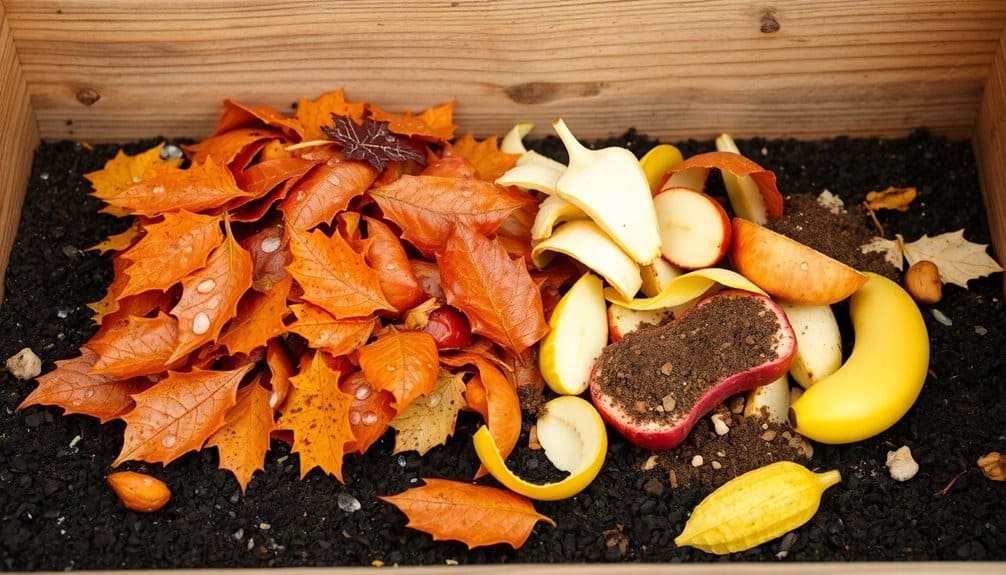
For centuries, cold composting has represented the traditional approach to organic matter decomposition, characterized by its passive methodology and ambient temperature degradation processes. You’ll find this method operating at temperatures between 50-85°F (10-29°C), considerably lower than its hot composting counterpart.
When you’re implementing cold composting, you’ll add organic materials incrementally as they become available, without strictly monitoring carbon-to-nitrogen ratios. The process relies on mesophilic microorganisms, which break down organic matter at a slower rate than thermophilic bacteria. While you won’t need to turn the pile frequently, decomposition typically takes 6-24 months to complete.
You’ll want to layer your materials in a 3:1 ratio of browns (carbon-rich materials) to greens (nitrogen-rich materials). The pile’s outer layers will insulate the core, where most decomposition occurs. Though you won’t achieve pathogen or weed seed destruction due to lower temperatures, you’ll still produce valuable humus-rich compost. This method’s primary advantages include minimal maintenance requirements and reduced water consumption, making it ideal if you’re seeking a low-intervention approach to composting. This eco-friendly approach can help divert organic waste from landfills by up to 30% of total household waste.
Hot Composting
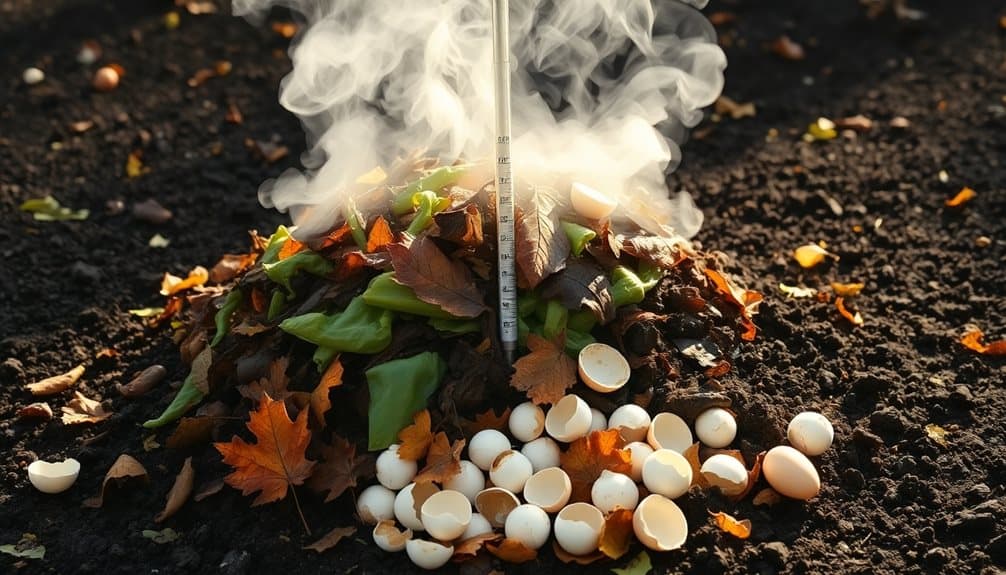
Unlike its slower counterpart, hot composting accelerates organic matter decomposition through elevated temperatures ranging from 130-150°F (54-66°C). This thermophilic process requires careful management of carbon-to-nitrogen ratios, moisture content, and oxygen levels to maintain microbial activity.
To achieve ideal decomposition, you’ll need to maintain a 30:1 carbon-to-nitrogen ratio while keeping moisture levels at 55-65%. The increased bacterial activity generates considerable heat, which helps eliminate pathogens and weed seeds. You’ll notice steam rising from your pile during the active phase, indicating successful thermophilic decomposition.
- Position your pile in full sun and construct it to a minimum size of 3’x3’x3′ to maintain thermal mass
- Layer nitrogen-rich materials (green waste) with carbon-rich materials (brown waste) in alternating 4-6 inch sections
- Monitor internal temperature daily using a compost thermometer, turning the pile when temperatures exceed 150°F
- Maintain proper aeration by turning the pile every 3-5 days during peak activity
When managed correctly, hot composting can produce finished compost in 4-8 weeks, considerably faster than traditional cold composting methods. The resulting material will be pathogen-free and rich in stable organic compounds.
Trench Composting
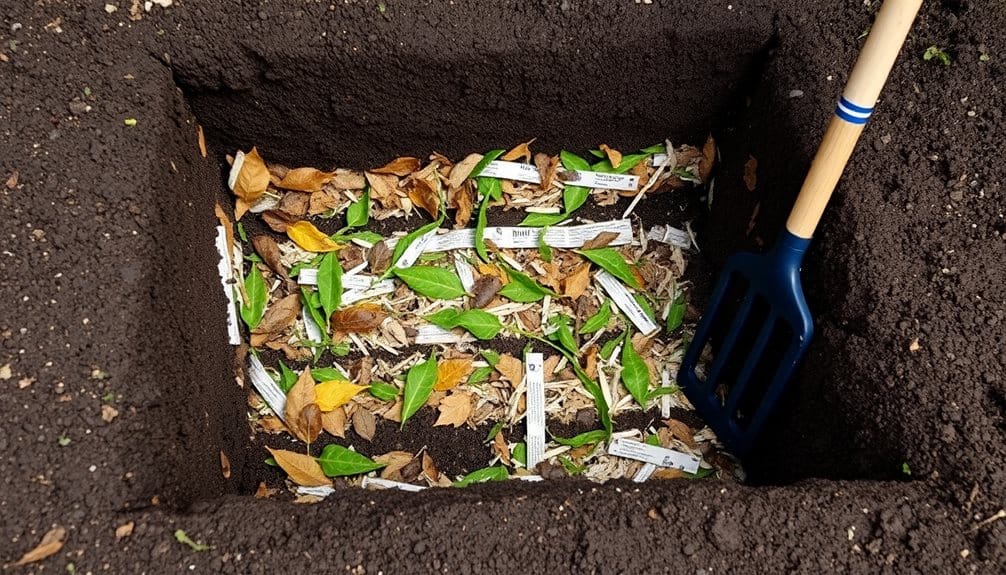
Trench composting directly integrates organic matter into the soil through strategically excavated channels, maximizing nutrient absorption and minimizing surface exposure. You’ll need to dig trenches 12-24 inches deep and 12-18 inches wide, placing kitchen scraps, yard waste, and other biodegradable materials directly into these excavated areas. This method’s effectiveness stems from its proximity to plant root zones and the soil’s indigenous microorganisms.
To implement trench composting, you’ll want to rotate your garden beds using a three-year cycle. In year one, dig your trench and fill it with organic matter. During year two, plant shallow-rooted crops like lettuce or herbs in the decomposed material. By year three, you can cultivate deep-rooted vegetables like tomatoes or squash in the fully processed compost.
The anaerobic decomposition process in trench composting doesn’t require the regular turning or moisture monitoring that’s essential in traditional composting methods. You’ll find this method particularly effective for nitrogen-rich materials like coffee grounds, vegetable scraps, and grass clippings, which break down rapidly in the soil’s ecosystem. Unlike worm composting systems, which require careful temperature monitoring between 55°F and 77°F, trench composting relies on the soil’s natural temperature regulation.
Electric Composting
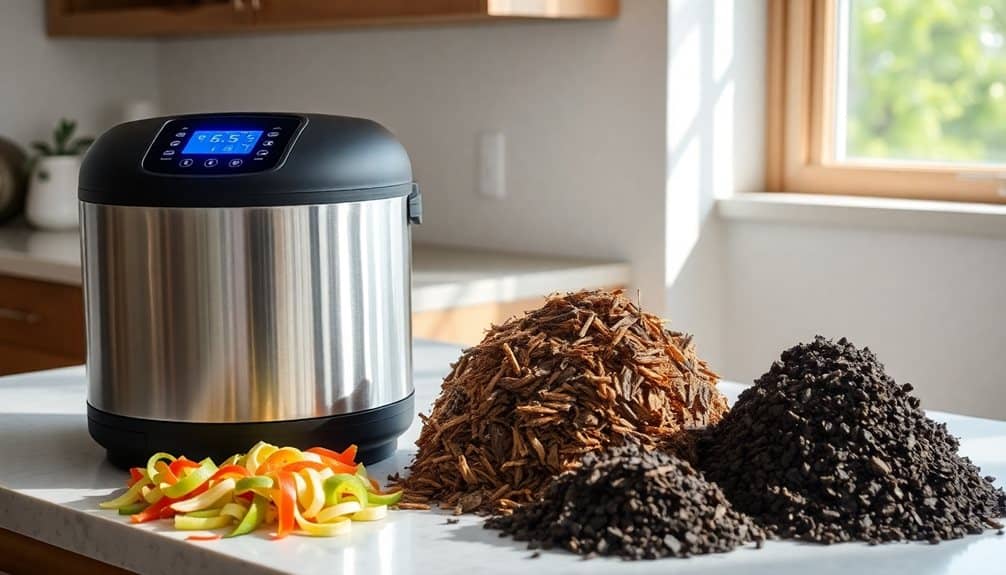
Electric composters represent a modern technological solution to traditional decomposition methods, utilizing automated systems to accelerate the breakdown of organic waste through precise temperature control and mechanical agitation. These units employ thermophilic processing, maintaining ideal temperatures between 55-65°C (131-149°F), which greatly expedites decomposition while eliminating pathogens and weed seeds.
You’ll find these units particularly effective for apartment dwelling or urban environments where traditional composting isn’t feasible. The process typically reduces organic waste volume by 90% within 24-48 hours, producing a sterile, nutrient-rich end product you can use as a soil amendment.
- Electromagnetic heating elements maintain consistent internal temperatures for ideal microbial activity
- Automated mixing mechanisms guarantee uniform decomposition through periodic agitation cycles
- Carbon filtration systems neutralize odors while facilitating aerobic breakdown
- Moisture sensors regulate humidity levels to prevent anaerobic conditions
When operating an electric composter, you’ll need to maintain a proper carbon-to-nitrogen ratio by mixing food scraps with provided carbon additives. The resulting output, while not traditional compost, functions as a concentrated soil enrichment supplement that’s immediately ready for incorporation into your growing medium. Most modern units feature smart technology integration that allows remote monitoring and control through smartphone apps.
Bokashi Fermentation
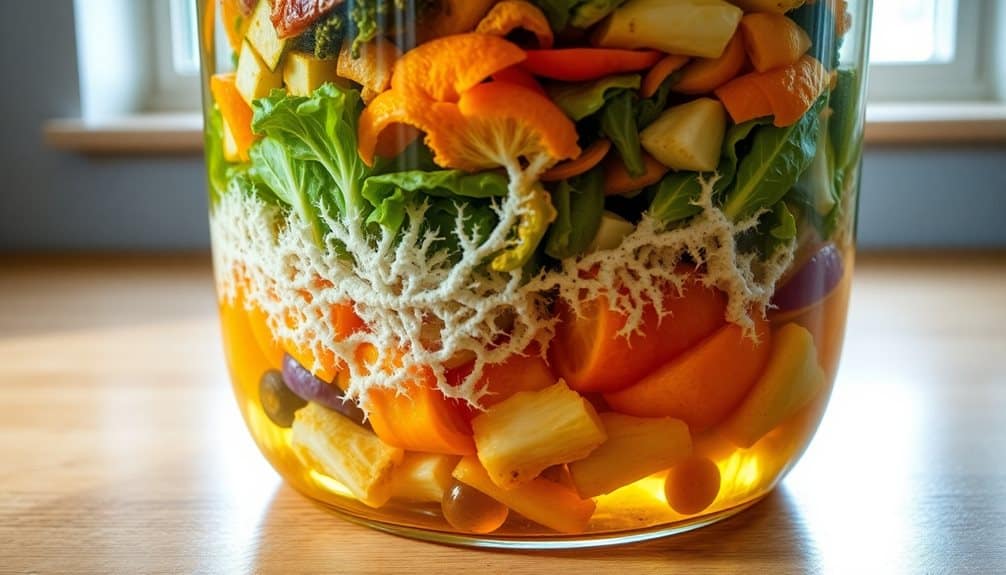
While electric composters rely on heat and mechanical agitation, Bokashi fermentation harnesses anaerobic microorganisms to break down organic matter through a controlled pickling process. This Japanese method utilizes specific strains of effective microorganisms (EM) and a carbon-rich substrate, typically wheat bran or rice husks inoculated with Lactobacillus bacteria, to ferment kitchen waste in an oxygen-free environment.
You’ll need an airtight container with a drainage spout to collect leachate, the nutrient-rich liquid byproduct of fermentation. Layer your food scraps, including meat and dairy that traditional composting can’t handle, with Bokashi bran. The fermentation process typically takes 10-14 days, during which the waste undergoes lacto-fermentation, producing beneficial enzymes and organic acids.
The resulting pre-compost material requires burial in soil for 2-4 weeks to complete decomposition. During this final phase, the acidic fermented matter neutralizes and integrates with the soil microbiome. The process yields highly bioavailable nutrients and beneficial microorganisms that enhance soil structure and plant growth, while considerably reducing methane emissions compared to traditional composting methods.
Sheet Composting
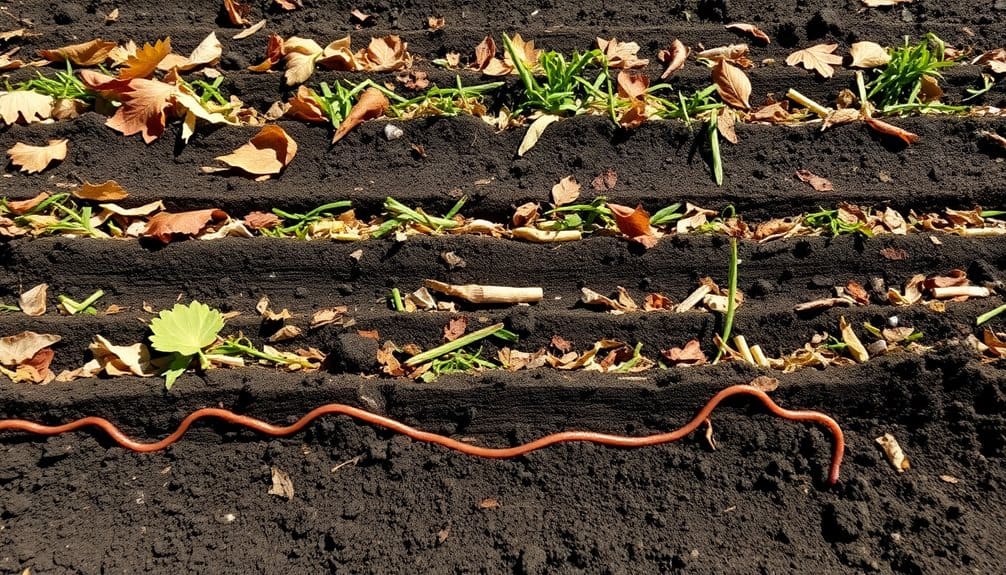
Sheet composting represents an in-situ decomposition method where organic materials are directly layered onto soil surfaces in a stratified arrangement. This technique facilitates the gradual decomposition of organic matter while simultaneously enriching the underlying soil matrix through natural biological processes.
You’ll need to implement specific layering protocols to maximize decomposition efficiency. The process begins with the mechanical reduction of organic materials into smaller particles, followed by systematic layering that promotes ideal carbon-to-nitrogen ratios.
- Layer 1 should consist of carbonaceous materials like shredded leaves or straw (4-6 inches)
- Layer 2 requires high-nitrogen components such as fresh grass clippings or kitchen waste (2-3 inches)
- Layer 3 incorporates a thin application of soil or finished compost to introduce beneficial microorganisms
- Final layer should include a moisture-retentive mulch to regulate hydration levels
During the decomposition phase, you’ll observe the gradual subsidence of materials as microbial activity transforms the organic matter. The process typically spans 3-6 months, depending on environmental conditions and material composition. This method’s primary advantage lies in its minimal maintenance requirements while providing direct soil enhancement benefits.
Container Composting
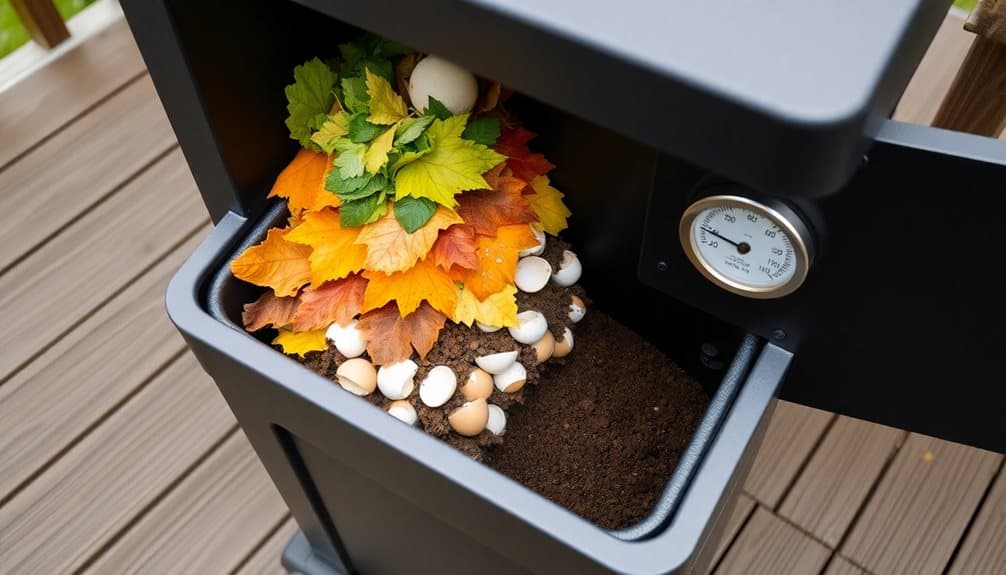
Container composting stands out as a controlled decomposition system wherein organic materials undergo aerobic degradation within enclosed vessels ranging from up to 100 gallons. You’ll need to maintain a carbon-to-nitrogen ratio of 30:1 while guaranteeing proper aeration through strategically placed perforations in your container’s structure.
The process requires layering your organic materials in a specific sequence: Begin with 6 inches of carbon-rich brown materials (lignin-based substances like wood chips or dried leaves), followed by 2 inches of nitrogen-rich green materials (fresh plant matter with high cellular content). You’ll need to maintain moisture levels at 55-65% throughout the decomposition process.
Your container system should include a leachate collection mechanism to capture excess moisture and prevent anaerobic conditions. Monitor internal temperatures using a composting thermometer; ideal microbial activity occurs between 135-150°F (57-66°C). You’ll need to turn the contents every 3-5 days during the initial thermophilic phase to guarantee uniform decomposition. The process typically achieves finished compost within 6-8 weeks, provided you maintain proper environmental conditions and material ratios.
Frequently Asked Questions
How Long Does It Take for Compost to Smell Like Earth?
Your compost will transform from raw materials to an earthy aroma in 2-6 months, depending on your management practices. Temperature, moisture content, carbon-to-nitrogen ratio, and microbial activity all influence the decomposition rate. You’ll notice the shift through distinct olfactory phases: from fresh organic matter to ammonia-like emissions, then to actinomycetes’ characteristic geosmin production, finally achieving that desired petrichor-like soil fragrance.
Can Composting Attract Unwanted Wildlife to My Property?
Your compost pile can attract wildlife if it’s not properly managed. Mammals like raccoons, rodents, and bears are drawn to food scraps, especially meat, dairy, and oils. To deter fauna, you’ll need to maintain proper carbon-to-nitrogen ratios (30:1), use enclosed bins with secure lids, bury fresh materials in the center, and avoid incorporating animal products. Regular aeration and moisture control (40-60%) also reduce scent dispersal.
Should I Continue Composting During Winter Months?
While winter’s icy grip slows nature’s recycling process, you shouldn’t put your composting efforts into hibernation. The decomposition continues, albeit at a reduced rate, as mesophilic bacteria remain active above 40°F (4°C). You’ll want to maintain proper carbon-to-nitrogen ratios, insulate your pile with straw or leaves, and continue adding kitchen scraps. Consider using a thermal compost bin to retain heat and accelerate decomposition during colder months.
What Should I Do if My Compost Becomes Too Wet?
If your compost becomes oversaturated, you’ll need to reestablish proper moisture equilibrium. Add carbon-rich materials like shredded paper, dry leaves, or sawdust to absorb excess moisture. Turn your pile frequently to improve aeration and accelerate evaporation. Make certain your drainage system is functioning properly, and consider relocating the pile to a location with better runoff. Monitor the moisture content until it reaches the ideal consistency of a wrung-out sponge.
How Can I Tell if My Compost Has Harmful Bacteria?
Want to guarantee your compost isn’t harboring dangerous microbes? Watch for warning signs like foul, putrid odors resembling ammonia or rotten eggs, which indicate anaerobic decomposition. Check for slimy textures, visible mold patches, or dark leachate. Monitor your pile’s temperature – it should reach 130-150°F (54-65°C) during the thermophilic phase to kill pathogens. If you’re composting food waste, avoid dairy, meat, or oils that attract harmful bacteria.




